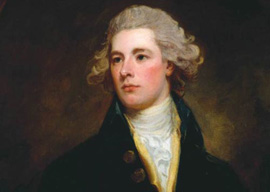
August 27, 2012

William Pitt the Younger, circa 1783 by George Romney
Pitt was handsome, so George Romney had no need to idealize. Yet his rendering of Pitt is the portrait of an ideal”that of political rectitude, intellectual sincerity, and incorruptibility. Can we find these things in Mitt, as Romney found them in Pitt? What a perfect mirror for comparison the humble ancestor has left for his famous descendent, if the latter only possessed the means of knowing it. If he did, he could stand before this portrait as I have and look with a special form of wonderment and therapeutic shame in all we have made of ourselves today.
Few these days will ever read a Thomistic treatise on moral virtues, or Plutarch’s Lives of the Noble Greeks and Romans, or Lord Macaulay’s histories. But all can draw meaning from Romney’s portrait of William Pitt the Younger. It is a visual treatise on a leader’s human and political virtues. Since it is visual, it is perhaps more accessible to our intellectually fallen world, where sensation replaces thought.
In reading Romney’s biography by William Hayley, the reader is astounded by the leitmotif attending almost every page: George Romney was humble. It was “without education, without patronage, without money” that Romney “raised himself, by the mere force of talents and industry to intellectual eminence.”
Were politicians committed to truth, they would not need to purchase their “eminence” with hundreds of millions of dollars.
George Romney died in rural obscurity, only to be celebrated in verse as a beloved hero of England.
As pundits evaluate Mitt Romney, the art world is sure to reexamine his illustrious forebear. I find him more interesting. Neither Gainsborough nor Reynolds ever achieved Romney’s sober introspection, or his loving attention to all that is best and brightest in his subjects. His canvases frame a lost world, one that today’s listless candidates would do well to emulate”where beauty, refinement, and truth were upheld as genuine values venerated forever in art’s fathomless mirror.